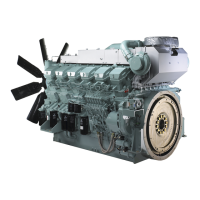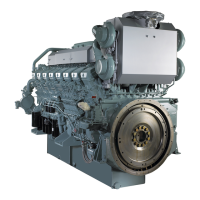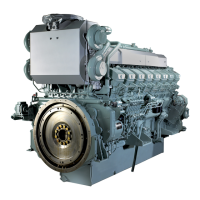Chapter 3 OPERATION
3-13
Operation
Do not approach rotating parts while in opera-
tion. Entanglement by rotating parts can cause
serious injury.
Do not touch any part of the engine while it is oper-
ating or immediately after it is shut down. A hot
engine can cause burns.
Provide adequate ventilation in the engine room. If
air supplied to the engine room is restricted, the
room temperature increases and can affect engine
output and performance.
During the first 50 hours of operation, break-in the
engine by operating it with light load and at lower
speed than normal.
Operating the engine under high load or severe
conditions during the break-in period can shorten
the service life of the engine.
After the warm-up operation, start operating the
engine with load.
Inspection During Operation
Check for leakages.
Inspect the exterior of the engine to make sure
there is no leakage from joints.
Check to make sure the engine does not produce
abnormal noise or vibrations.
Inspect the engine for abnormal operating sound
and vibrations such as knocking.
Check to make sure the exhaust gas is normal
color.
Check the color of the exhaust gas discharged from
the exhaust pipe.
Note: Regarding abnormal exhaust gas conditions,
refer to "Engine Produces Large Amount of
Smoke While in Operation" (9-8).
Check to make sure that the mist discharged from
the breather is not abnormal in the amount or color.
Check to make sure the instruments and gages
indicate normal values.
Note:(a) When the oil pressure drops below 0.29
MPa (3 kgf/cm
2
) [42.7 psi] in normal oper-
ation, or below 0.10 MPa (1 kgf/cm
2
) [14.2
psi] at minimum speed with no load, stop
the engine immediately. Before restarting
the engine, check and correct the cause of
the problem.
(b) When the high temperature alarm switch
is activated in normal operation, change
the engine operation immediately to no-
load idling condition until the engine tem-
perature decreases to normal operating
level. Then, operate the engine for
another 5 or 6 minutes for cooling before
stopping the engine.
Before restarting the engine, check and
correct the cause of the problem.
If the above inspection finds an abnormality, stop
the engine immediately, correct all problems, and
restart the engine. If the engine cannot be repaired,
contact a Mitsubishi dealer.
Table 3-2 Data for rated speed
Item Standard value
Engine oil
pressure
No load,
low idling
speed
0.20 to 0.39 MPa
(2.0 to 4.0 kgf/cm
2
)
[29 to 56.56 psi]
Rated
speed
0.39 to0.69 MPa
(4.0 to 7.0 kgf/cm
2
)
[56.56 to 100.08 psi]
Engine oil
temperature
70 to 100 °C
[158 to 212 °F]
Jacket coolant
pressure
0.05 to 0.34 MPa
(0.5 to 3.5 kgf/cm
2
)
[7.25 to 49.31 psi]
Jacket coolant
temperature
65 to 85 °C
[149 to 185 °F]
Oil cooler/air cooler
coolant pressure
0.05 to 0.34 MPa
(0.5 to 3.5 kgf/cm
2
)
[7.25 to 49.31 psi]
Oil cooler/air cooler
coolant temperature
30 to 85 °C
[86 to 185 °F]
Exhaust
tempera-
ture
Cylinder
outlets
250 to 650 °C
[482 to 1202 °F]
Turbo-
charger
outlet
250 to 600 °C
[482 to 1112 °F]

